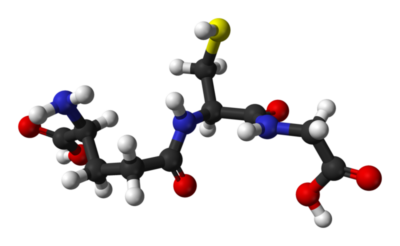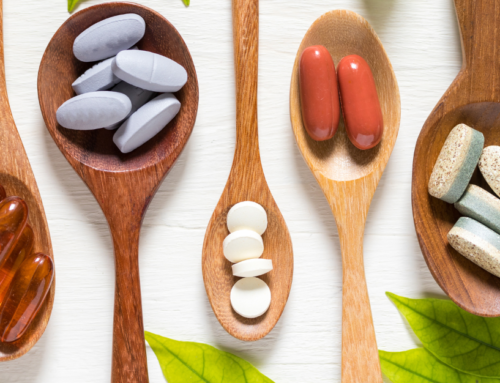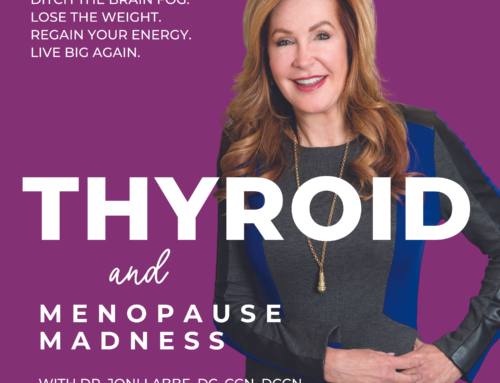You’ve heard antioxidant foods and supplements can help fight inflammation, protect you from toxins, and help manage autoimmune diseases, but the most important antioxidant is one we make in our own bodies: glutathione.
 Unlike common antioxidant sources — vitamins C and E, beta carotene, turmeric, resveratrol, and foods such as blueberries, tomatoes, and red wine — you can’t take plain glutathione as it’s too hard to absorb. However, you can take glutathione precursors or special forms of glutathione that can be absorbed by the body.
Unlike common antioxidant sources — vitamins C and E, beta carotene, turmeric, resveratrol, and foods such as blueberries, tomatoes, and red wine — you can’t take plain glutathione as it’s too hard to absorb. However, you can take glutathione precursors or special forms of glutathione that can be absorbed by the body.
Glutathione: the “master antioxidant”
Antioxidants are molecules that inhibit other molecules from going through oxidation, a chemical reaction that produces toxins called free radicals.
Free radicals are unstable molecules created as a result of natural biochemical processes. We can also ingest them via toxins in food, air, water, and even medication. Left unchecked, free radicals damage cells and contribute to the development of serious health problems such as Hashimoto’s hypothyroidism.
While we need plenty of dietary antioxidants from varied and plentiful fresh fruits and vegetables, our most powerful antioxidant source is the glutathione our bodies produce.
In fact, glutathione is so powerful it’s referred to as the “master antioxidant.”
Two vital duties of glutathione
Two of glutathione’s most important duties are promoting liver detoxification and dampening inflammation.
- Liver detox. In the liver, glutathione binds with toxins to help move them out of the body. This process is so effective people who overdose on Tylenol receive an IV infusion of NAC (N-acetyl cysteine), a precursor, or building block, for the body to produce more glutathione.
- Inflammation and immune function. When you have enough glutathione in your cells, it “takes the bullet” by offering itself up to free radicals so they don’t attach to and damage cells, such as the thyroid in Hashimoto’s hypothyroidism.
However, when your glutathione reserves are too low, free radical damage can spiral out of control, leading to cell damage and the foundations for inflammatory health condition such as:
- Intestinal permeability (leaky gut)
- Chemical sensitivities
- Heavy metal sensitivities
- Autoimmune diseases and flares
- Inflammatory and immune disorders
Glutathione depletion is also linked to a number of other disease states and groups:
- Aging
- Athletic overtraining
- Major injuries and trauma
- Patients with wasting diseases such as HIV and AIDS
- Lung cancer
- Gut-based diseases such as Crohn’s and ulcerative colitis
- Chronic fatigue syndrome
- Alcoholism and fatty liver disease
- Diabetes and low glucose tolerance
- Cancer
In many of these cases, raising glutathione levels has shown therapeutic benefits.
Support glutathione’s antioxidant status
In these overly-stressed times of inescapable toxic burdens, it’s nearly impossible to maintain proper glutathione levels strictly through diet. You can find plain glutathione over-the-counter, but it’s not worth taking because your gut breaks it down before you can use it.
However, it is possible to support your glutathione status in the following ways:
- S-acetyl glutathione is one of the newest and most accessible forms of glutathione that the intestinal tract can efficiently absorb. It can be helpful in managing autoimmunity.
- Oral liquid liposomal glutathione covers two bases by providing both bioactive glutathione and glutathione precursors that help your body make glutathione inside the cells.
- Liposomal cream is used in localized areas of pain or inflammation, such as an inflamed knee or on the thyroid for autoimmunity.
- IV drip is highly effective but is expensive and difficult to access for some patients.
Other glutathione delivery methods include glutathione suppositories, glutathione nebulizers, and sublingual glutathione. All of these methods can help you better support management of your Hashimoto’s hypothyroidism.
Support glutathione recycling for optimum immune function
It’s important for the body to be able to make glutathione inside the cells to protect mitochondria, the energy-producing factories that lie at the foundation of our health and longevity. To do this, the body must be able to recycle glutathione.
For glutathione to be recycled, it must be reduced:
There are two main forms of glutathione in the body:
- Reduced glutathione
- Oxidized glutathione
When there is plenty of reduced glutathione in the cells, they sacrifice themselves to free radicals — “taking the bullet” as previously mentioned — to protect the precious mitochondria. An enzyme called glutathione peroxidase triggers the conversion of reduced glutathione to oxidized glutathione, a free radical itself.
However, when there is sufficient glutathione in the cell, the newly unstable oxidized glutathione pairs with available glutathione with the help of an enzyme called glutathione reductase. This sends it back to reduced glutathione status and ready for duty.
To support glutathione recycling, it is important to first reduce stress on the body:
- Balance blood sugar
- Restore gut health
- Address food intolerances: An elimination diet or a lab test can help you determine which foods are responsible
- Support your Hashimoto’s hypothyroidism through other functional medicine strategies
- Manage hormonal imbalances
- Get plenty of sleep
- Cut down on an over-committed schedule
- Get adequate exercise
- Make time for play and enjoyment
- Minimize exposure to toxins in and out of the home
If these factors don’t bring the needed relief, then the following botanicals and nutritional compounds can help support glutathione recycling:
- N-acetyl-cysteine (NAC) is rapidly metabolized into intracellular glutathione.
- L-glutamine is important for glutathione generation.
- Alpha-lipoic acid (ALA) directly recycles and extends the metabolic life spans of vitamin C, glutathione, and coenzyme Q10, necessary for glutathione recycling.
- Selenium is a trace element that serves as the essential cofactor for the enzyme glutathione peroxidase, which converts reduced glutathione to oxidized glutathione so glutathione can “take the bullet” to protect cells.
- Milk thistle significantly increases glutathione and positively influences the ratios of reduced and oxidized glutathione.
- Gotu kola increases the activity and amount of glutathione peroxidase and the quantity of glutathione.
- Cordyceps activates glutathione synthesis and protects cells by engaging the glutathione enzyme cycle.
Taken together these botanicals and compounds activate the glutathione peroxidase and reductase enzymes to promote a healthy glutathione recycling system.
To optimize your glutathione levels and recycling and better manage your Hashimoto’s hypothyroidism, please contact our team for guidance.





